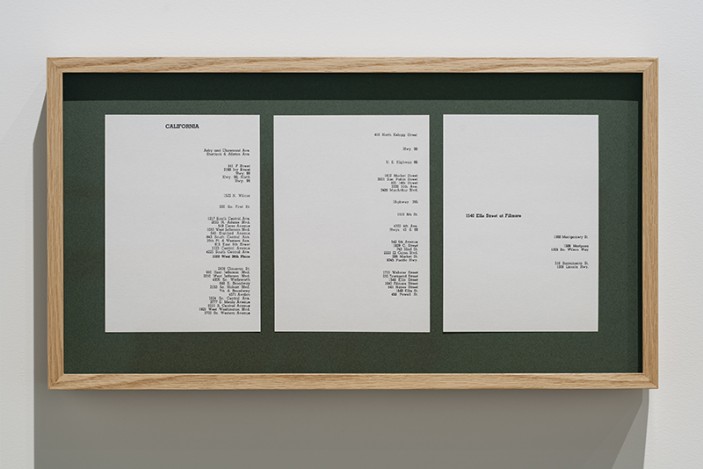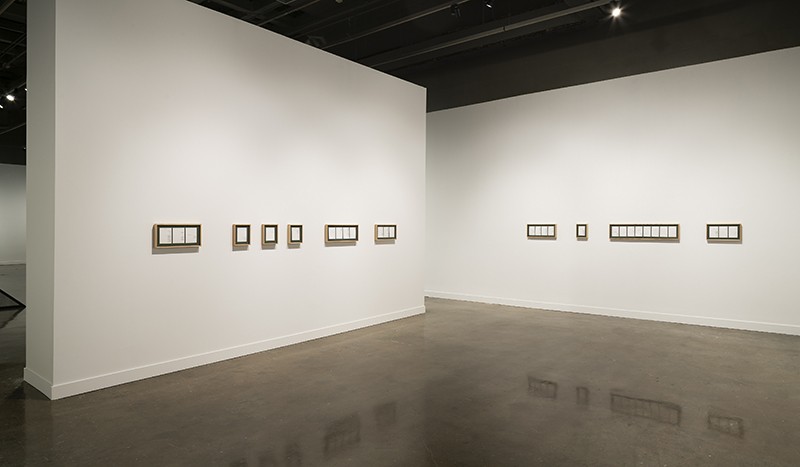Isabella Cura is a graduating senior at Northeastern University, majoring in marketing and graphic design. She has worked as a co-curator for spark, Northeastern’s contemporary art collective, and is currently working as a graphic designer for Northeastern’s Artistry Magazine while she pursues a full-time career in marketing analytics after graduation. She is passionate about bringing diverse voices to contemporary art.
VoCA is pleased to present this blog post in conjunction with Associate Professor of Contemporary Art History, Gloria Sutton’s Spring 2019 Honors seminar, The Art of Visual Intelligence at Northeastern University. This interdisciplinary course combines the powers of observation (formal description, visual data) with techniques of interpretation to sharpen perceptual awareness allowing students to develop compelling analysis of visual phenomena.
For Yuri Stone, Assistant Curator at the MIT List Visual Arts Center in Cambridge, artist intent is always at the forefront of his work. Most recently, he’s worked on a solo exhibition with artist Kapwani Kiwanga, focusing on the history of racialized surveillance in America from the colonial-era lantern laws to the Green Book to power dynamics within surveillance that black Americans still experience today. The exhibition is called “Safe Passage,” and at first glance, the space feels exactly that: a vast, high-ceilinged and white-walled space filled with sharp angles and geometric shapes, soft light from five-foot sculptures, a glass partition, a walled separation. Each piece leads you to the next. And as natural as the space feels, all the decisions were intentional. So how was Yuri Stone able to curate an exhibition with so much to say in such an impactful yet subtle way? I spoke with him to find out just how artist intent plays into his work.

Installation view, Kapwani Kiwanga: Safe Passage, MIT List Visual Art Center, Cambridge, MA, 2019. Artwork © Kapwani Kiwanga. Image courtesy MIT List Visual Arts Center. Photograph by Peter Harris Studio.
First off, Stone’s general approach is artist-centric. He’s always believed in letting the artist lead the conversation. In his own words, it’s “equal parts staying out of the way and maneuvering how best to support my artist. If the curator’s hand is visible, then they’re doing something wrong.” His work approach—the trick of making the artworks in the exhibition seem like they were made for that space and that time—appears simple, yet takes skill to perfectly execute.
Looking specifically at “Safe Passage” and working with Kiwanga, Stone truly believes it was a wholly collaborative effort: “I followed her lead because she’s so driven and thoughtful when it comes to these things.” He’s had a long history of working with artists who are working with archives, and after seeing some of her work in Chicago, Stone was immediately inspired and intrigued. “She was looking at culturally loaded moments in a very interesting way. The artists I’m attracted to make work that challenges me and forces me. It entices me to dig into it—What does it mean? Why did she do that? What is it about mounting a fluorescent light in the middle of a gallery that makes the space feel that way?”
For this exhibition, I couldn’t help but wonder if one voice had more influence than the other. This was not the case. “It’s always flexible,” Stone assured me. “There’s always some sort of conversation. You agree to do a show with the understanding that, ‘This is a person whose judgment and taste I trust, and they’re just as supportive of me as I am of them.’ I put my objectives out there as early as possible, so the artists are able to say no. If Kapwani wanted to make a different show, she would have brought it up at the beginning. My approach is putting it all on the table: this is what I like about you, this is what I like about your work, and this is what I want to accomplish.”
Stone also focuses on spatial quality. As natural as the space feels, the decisions are all intentional, methodical, and all collaborative. “Understanding the scale of the artworks and the sort of linear way that people move through the space is where I insert myself. I worked with Kapwani to see how many sculptures, where to place things, where to place the dividing wall for Green Book.” The book Kiwanga’s work refers to has recently come into the public eye with the popular movie of the same title, and has popped up in popular culture in Derrick Adams’ show at the Museum of Art and Design or by setting an auction record at Swann Galleries’ “Printed & Manuscript African America” auction. The book—formally known as “The Negro Motorist Green Book” —traditionally served as a guidebook for African Americans, listing restaurants, hotels, and other places that were considered relatively safe and friendly towards African Americans in the height of the Jim Crow laws era.

Installation view, Kapwani Kiwanga: Safe Passage, MIT List Visual Art Center, Cambridge, MA, 2019. Artwork © Kapwani Kiwanga. Image courtesy MIT List Visual Arts Center. Photograph by Peter Harris Studio.
Kiwanga’s Green Book installation is separated from the sculptural aspect of the exhibition by a partitioned wall. Around 25 natural wooden frames hang close to eye level on clean white walls. Inside are minimal, typographically aesthetic pages from the Green Book—extra text and advertisements have been removed, leaving only addresses and the name of the state. The frames vary in length: some house as many as eight pages, some keep only one. Little decisions would otherwise go unnoticed, but Stone says that each decision was made with purpose. “Kapwani and I sat together for a full day to figure out sequence, spacing, variations, why. And that was the fun part. It was cool to see how she thinks visually.” The decisions are impactful, from the minimalistic treatment and clean typography to the simultaneous separation and collection. Together they create a beautiful, quiet moment from the Green Book that is juxtaposed by the underlying reminder of prejudice and racism.

Stone’s approach is important. His advocacy of artist intent allows these stories to not only be heard but lauded, and his curation has a level of grace that guides the artist without hindering them. It gives the final exhibition and artist a platform that captures the visitor and makes them think about it long after they’ve left. “I think it’s important to use our platform and resources to look at these brutal and challenging histories,” Stone said. “A thoughtful artist can do it in dynamic ways and allows a complex thing to be open enough that everyone engages with it thoughtfully, differently, and doesn’t take it lightly.”
